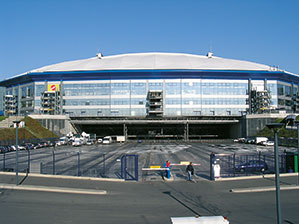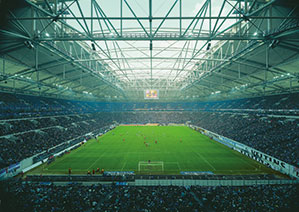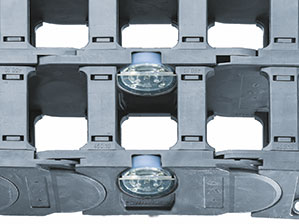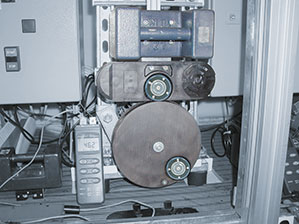Six star stadium at Schalke
Roller energy chains moves the playing field of the VELTINS arena in Gelsenkirchen
When the games start in Gelsenkirchen and the football teams square off, only winning or losing matters. But here as well: nothing goes without technology. The players dominate on the playing field, and below the playing field, a maintenance-free roller energy chain demonstrates its strength when the grass surface is moved.
"The world has never seen such a stadium", FIFA President Joseph Blatter raves about the VELTINS arena at Schalke. The European Football Federation UEFA has classified the multi-functional game venue into its highest category as a "Five star stadium": The venue more than meets the requirements and could even be rated as a "Six star stadium". " One of its hallmarks is the mobile playing field. With the help of two space-saving roller energy chains and special cables made by igus® GmbH from Cologne, it travels on a single route of 170 m.
These hymns of praise underscore the resonance the arena has received since its commissioning in August of 2001. It quickly established itself as one of the continent's most advanced event venues. UEFA classified the stadium into the highest classification 4. Millions of people have until now not only attended athletic events. The bandwidth ranges from stock car races to music concerts and biathlons.
The stadium is completely financed with private sector funds and compels with its technology. The mobile grass field, the retractable roof, the sliding south bleachers, and the giant video cube under the roof are only some of the technical highlights. The "Knappenkarte" has been established as a cashless payment system based on a chip card. The tickets are also based on chip technology and provide smooth and reliable access control.
The playing field of the VELTINS arena is more than green grass. Bedded onto a 118 m long and 79 m wide tray, it is the only mobile lawn within the Bundesliga, and can travel back and forth for a distance of approx. 340 m. It was modeled after the Gelredome in Arnhem (Netherlands).
The grass surface is essentially only in the stadium during games. The exterior storage ensures ideal conditions for the sensitive grass surface. The stadium bleachers are high and generally prevent direct sun irradiation. This noticeably affects the lawn, which would otherwise need to be replaced every few months with expensive sod“, explains Michael Blaß, Sales Manager for energy chains and other products at igus® GmbH in Cologne. "And our roller energy chain is used for the power supply to move the field. They require very little room and have demonstrated their strength from the beginning. “
The principles behind the mobile playing field are relatively straight-forward. The 11,000 tonne tray is inserted into and retracted from the arena just like a drawer. 16 steel rails were integrated into secondary floor, the foundation, to ensure that this works smoothly. Each rail is 25 cm wide and 300 m long. The tray with the lawn is transfered into the arena on these.
The field is moved by four hydraulic presses, so-called gripper jacks. The presses move the playing field forward at one-and-a-half metres per minute. The motor then releases itself from its anchor, advances the ram on the steel rails in the secondary floor, clamps back down and re-engages. The entire process lasts 3.5 to 4 hours.
The roller energy chain, rol-e-chain®, is predestined for applications in which long travels are executed at high speeds. This is the case for instance in photo-finish cameras or in materials handling systems. Savings can be achieved even in slower applications in the crane sector or in shunting facilities due to the low friction coefficients of the system, as the drives can be dimensioned considerably smaller.

An 11,000 tonne tray with the playing field is moved with roller energy supply systems! Particularly for long travels, the so-called "rol-e-chain®" has distinct advantages over conventional, gliding applications.

The grass surface is essentially only in the stadium during games.

Energy chain, with rollers integrated into the side plate – resistant to dirt and space-saving.

A roller test stand at our in-house lab performs extensive energy chains tests that are specifically tailored to customer requirements.
At a speed of 1.5 m/min and an acceleration of 0.1 m/s2, the system in Gelsenkirchen uses two parallel tracking energy supply systems for the long travel of approx. 170 m. Two additional shorter, approx. 4 m long energy supply systems are part of the overall concept to implement the shunting mechanism.
"A significant aspect of this application is that the energy supply system must be resistant to weather. It is essential that it works in any weather", Michael Blaß underscores one of the main requirements. "The high additional load with the long travel is an additional requirement. Based on this combination, we decided to go from our standard chain to a roller chain. The rollers are integrated into the side plates. This reduces the drive power required to move the energy chain by 75%. Of course, wear is dramatically reduced. In addition, the rollers prevent the upper run from freezing onto the lower run during winter. From the very beginning, the chain worked flawlessly under all environmental conditions!"
But the delivered scope included more. "We not only supplied the energy supply system, but also equipped it with our special chainflex® cables", explains Michael Blaß. chainflex® refers to special purpose cables for energy chain systems that have been extensively tested under real-world conditions by our in-house lab.
All employed cold-flexible TPE control and power cables can be used at a temperature range of -35 °C to +100 °C in indoor and outdoor applications. "We are the first company to develop complete energy chains systems. Cables and energy chains are sold from a single source, based on the application and including a system guarantee", Michael Blaß explains. Customers have the advantage that the number of interfaces is reduced. And if technical problems unexpectedly occur, the specialists are always on call.